Feeling a little lost when it comes to your referral program? Be honest—do you know if it’s working? Sure, customers might be sharing referrals, but are they bringing in new business or just ghosting your efforts?
And those sweet incentives you’re handing out—are they motivating anyone or just nibbling away at your profits?
Here’s the kicker. If you’re not tracking results, how do you know if your referral campaign is driving growth or just spinning its wheels? What should you measure—referral rates, customer lifetime value, revenue impact?
And once you have those numbers, what do they even mean?
Ignoring referral marketing KPIs is like trying to win a race without a finish line. But with the right metrics, you can pinpoint what’s crushing it, fix what’s flopping, and turn your referral program into a revenue engine.
This article can help you figure these KPIs out, how to use them, and more.
What Are Referral Marketing KPIs?
Key Performance Indicators (KPIs) are the secret sauce for measuring whether your goals are hitting the mark. These are specific, measurable metrics that cut through the noise and show you what’s actually working.
Without them, you’re flying blind, hoping your efforts pay off. (Spoiler alert—they probably won’t.)
Now, when it comes to referral marketing, KPIs step up their game. They’re tailored to show you how well your program performs—how many referrals are rolling in, how well they convert to customers, and how much revenue they bring.
Every referral tells a story, and KPIs ensure you’re reading it right.
So, what’s the point of all this? KPIs don’t just spit out numbers; they hand you insights. Are your rewards resonating? Are referrals leading to high-value customers? KPIs give you those answers, loud and clear.
Here’s the real kicker. With KPIs, you unlock the power to tweak, optimize, and elevate your referral strategy. Want the program to thrive? You need KPIs to see where to focus and what to fix.
Without them, you’re basically guessing at what works—and who has time for that? Get intentional, track smart, and make your referral marketing more profitable.
Why Referral Marketing KPIs Are Unique
Referral marketing isn’t your typical marketing play. It thrives on trust, relationships, and genuine customer recommendations—no flashy ads needed.
That’s why tracking its success works differently compared to traditional strategies. You’re not banking on clicks and impressions; you’re watching how real people share and act.
Ordinary metrics don’t cut it here. Referral programs require specific, custom KPIs because they focus on advocacy, sharing, and conversions. You need to measure more than just how often something gets recommended.
You need to track how many referrals turn into sales and loyal customers. Without these tailored KPIs, you’re stuck guessing what’s actually driving results.
Here’s where it gets interesting—referral KPIs unlock invaluable insights. They tell you who your best referrers are and which rewards encourage real engagement.
You’ll discover what keeps customers sharing and where your program hits roadblocks. These metrics offer clarity about your program’s true impact on growth and profitability.
Referral KPIs are unique because they connect actions directly to results, not just surface numbers. Understanding these metrics helps you fine-tune your strategy instead of throwing spaghetti at the wall.
The Connection Between KPIs and Success
Tracking KPIs bridges the gap between referral marketing efforts and overall business goals. Each metric offers clarity and a measurable way to assess whether campaigns align with growth strategies.
For example, referral rates and conversion rates directly reflect your ability to attract loyal, engaged customers.
When KPIs sync with business objectives, your marketing becomes more than creative—it becomes effective. They ensure every referral program decision supports your bigger-picture goals.
KPIs transform guesswork into data-driven strategies that fuel success and growth. You’ll identify which tactics bring the highest returns and engagement. Metrics like referral revenue or customer lifetime value reveal your program’s financial weight.
Tracking also helps you optimize, spotting areas to tweak and improve before issues snowball. Understanding KPIs empowers you to make precise, impactful adjustments rather than chasing vague targets.
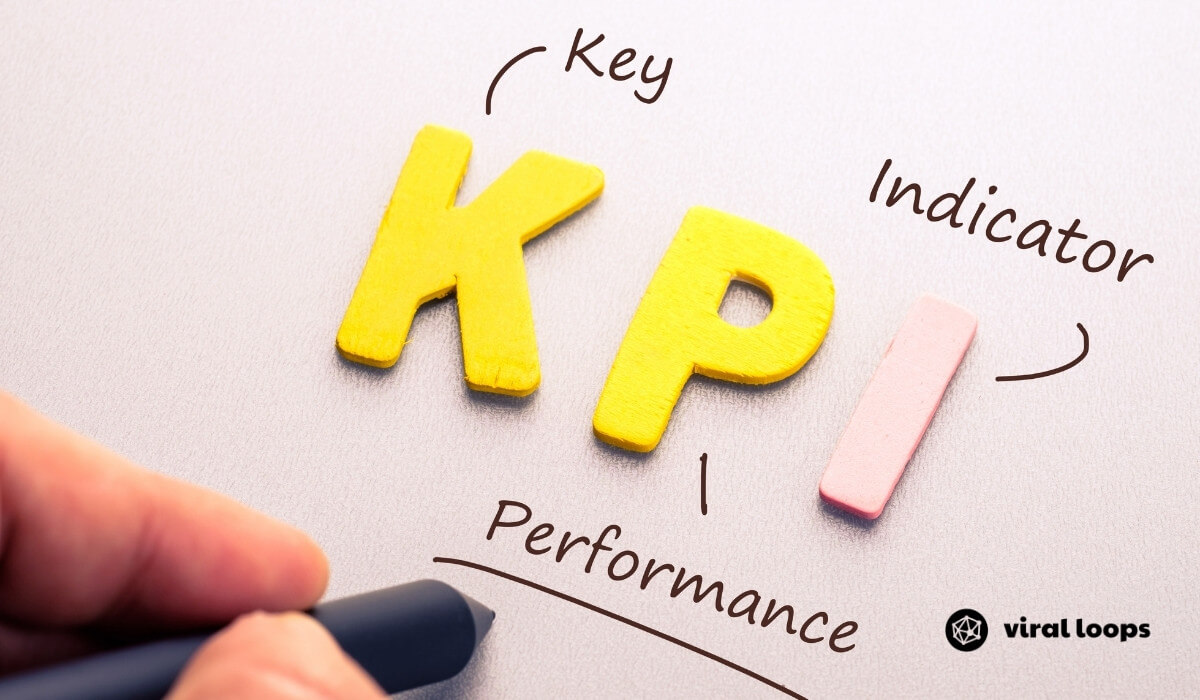
Usual Pitfalls of No Proper KPI Tracking
1. Lack of Clarity on Campaign Performance
Proper KPI tracking is essential to understanding how your referral programs perform. Without it, you’re left guessing outcomes instead of measuring success. Metrics like conversion rates and referral rates highlight valuable performance data.
Neglecting KPIs means you won’t know which campaigns resonate and which fall short. Guesswork risks wasting valuable time and marketing resources. To drive results, you need clear insights, not assumptions, about what’s working in your program.
2. Missed Opportunities for Optimization
Failing to track KPIs also blocks chances to optimize your efforts. Missing key patterns prevents meaningful program improvements.
For example, you can’t identify drops to fix without monitoring referral rates before they impact growth. Metrics such as customer lifetime value and program engagement help guide strategy improvements.
When you don’t measure KPIs, critical opportunities slip through the cracks. Optimization becomes guesswork instead of a targeted, data-driven process.
Categories of Referral Marketing KPIs
1. Core Performance KPIs
Core performance KPIs reveal how well your referral program delivers measurable results. They are used to:
- Track conversion rates to see how often referrals turn into customers.
- Measure referral rates to understand how frequently your current customers recommend your brand.
These metrics provide solid insight into whether your program effectively drives new business.
2. Engagement-Driven KPIs
Engagement-driven KPIs highlight how involved and satisfied your customers feel with your referral program. They are used to:
- Monitor customer participation levels to evaluate how many people actively engage with your incentives.
- Use net promoter scores (NPS) to gauge overall satisfaction and likelihood of customers recommending your brand.
These KPIs ensure your program fosters loyalty and enthusiasm.
3. Financial Impact KPIs
Financial impact KPIs show how your referral program directly benefits your bottom line. They are used to:
- Calculate customer lifetime value (CLV) to determine a referred customer’s long-term worth.
- Measure revenue generated from referrals to see how much income your program delivers.
These numbers clearly show the financial return on your referral investments.
Common Referral Marketing KPIs You Should Track
Tracking the right KPIs in referral marketing is like having a GPS for your program’s success—it keeps you on the right path and reduces guesswork.
But don’t worry; you don’t need to be a data scientist to master this! You can spot what’s working, fix what’s not, and uncover golden opportunities to elevate your results by keeping an eye on the numbers that matter.
Think of these KPIs as your secret weapons for building a referral program that thrives.
Now, let us examine the actual metrics that can transform a good strategy into a stellar one.
1. Participation Rate
Referral participation rate measures how many customers join your program and actively participate. It reflects how engaging and attractive your referral program is to users. You can calculate it using this formula:
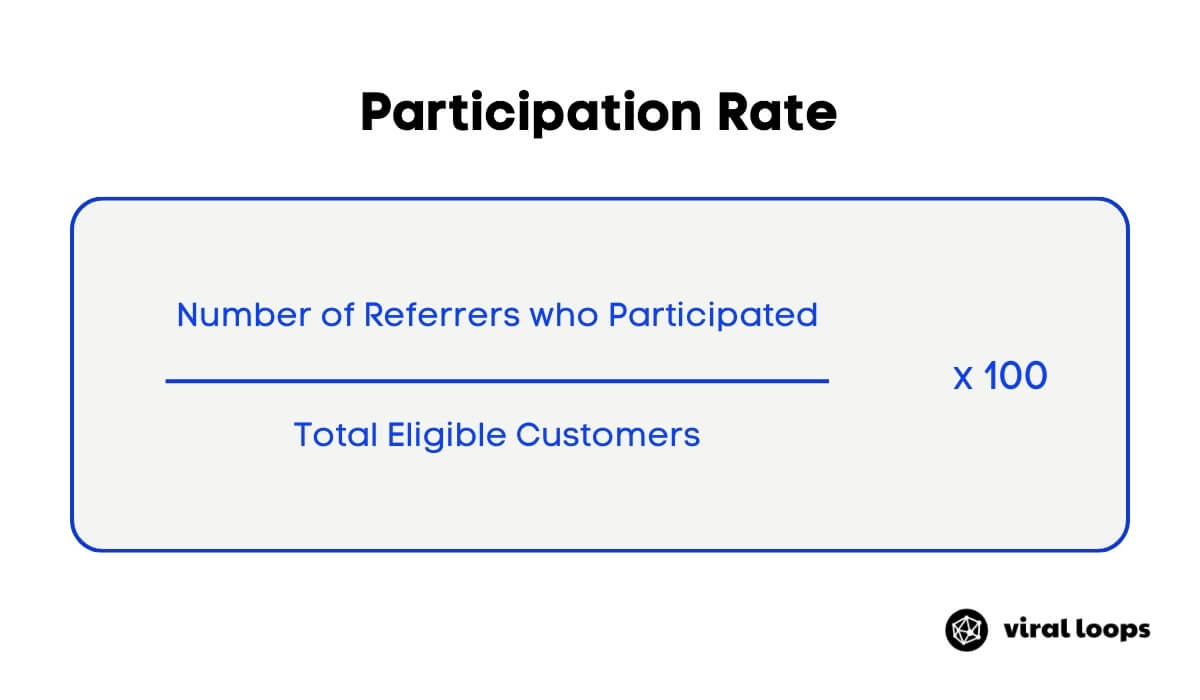
Monitoring participation metrics ensures you stay informed about what works and where adjustments are needed. Focus on these metrics to enhance your program’s appeal and maximize its potential.
2. Net Promoter Score (NPS)
Enter the sparkling star of customer satisfaction—Net Promoter Score (NPS). This little wonder measures how likely your customers are to recommend you.
And the formula? It’s simple yet powerful.
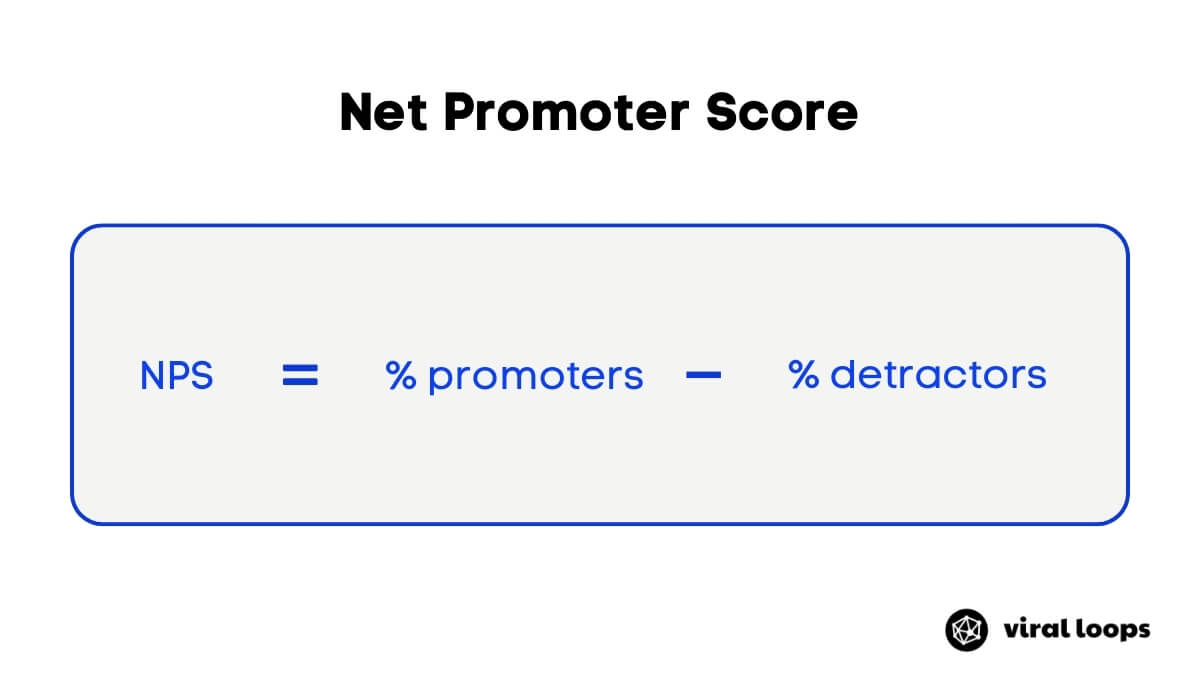
Subtract the percentage of Detractors (those scoring 6 or below on the recommendation scale) from the percentage of Promoters (those scoring 9 or 10). Boom—there’s your NPS.
Here’s the best part—referrals and NPS go hand in hand. A stellar NPS means customers are buzzing about your brand, and are willing to share it like their latest binge-worthy series. And more referrals? They can nudge your NPS even higher. It’s the ultimate viral growth loop.
3. Referral Conversion Rate
When it comes to referral programs, tracking your numbers isn’t just helpful—it’s essential. Enter the Referral Conversion Rate, the metric that tells you how many referred leads actually turn into paying customers.
It’s calculated using this simple formula:
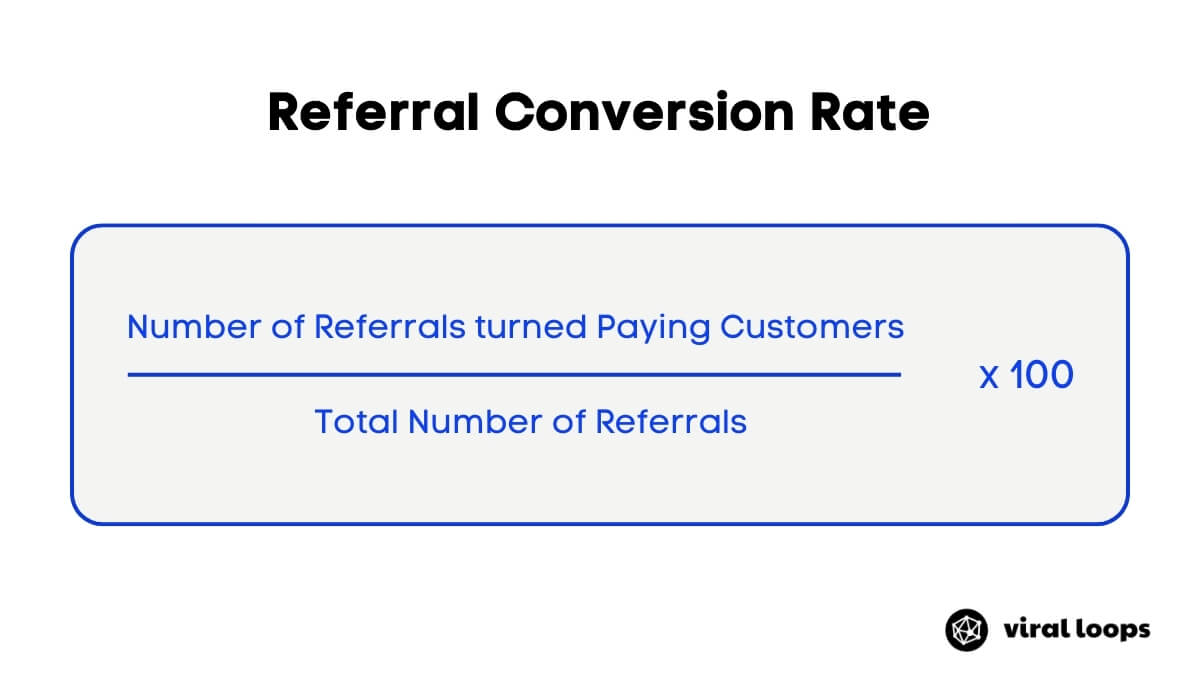
This metric is particularly valuable because:
- It focuses on revenue-generating conversions rather than just general conversions
- It helps measure the quality of referrals in terms of actual business impact
- It can be used to calculate the customer acquisition cost through your referral program
This number is your program’s scoreboard, showing whether your referrals deliver real results or just racking up clicks.
Digging deeper into this metris reveals where things might go off course. Are your leads dropping off at checkout? Could your landing page or messaging be clearer? Identifying these gaps gives you the data to tweak and optimize your pages and program for better conversion from lead to actual paying customer.
4. Referral Offer Redemption Rate
But don’t forget those incentives! That’s where the second MVP arrives in the scene: the offer redemption rate.
The Redemption Rate tracks how many referrals claim your rewards, like discounts or bonuses.
A high redemption rate? That means your incentives are hitting the sweet spot and motivating leads to take action.
If your rewards aren’t converting, it’s time to reimagine them.
5. Customer Lifetime Value (CLV)
Alright, time to put on your number-crunching hat and talk CLV—Customer Lifetime Value. It’s not just a fancy acronym.
Customer Lifetime Value is your golden ticket to understanding how much revenue a customer adds to your brand over their entire relationship with you.
And here’s the killer formula behind it all:
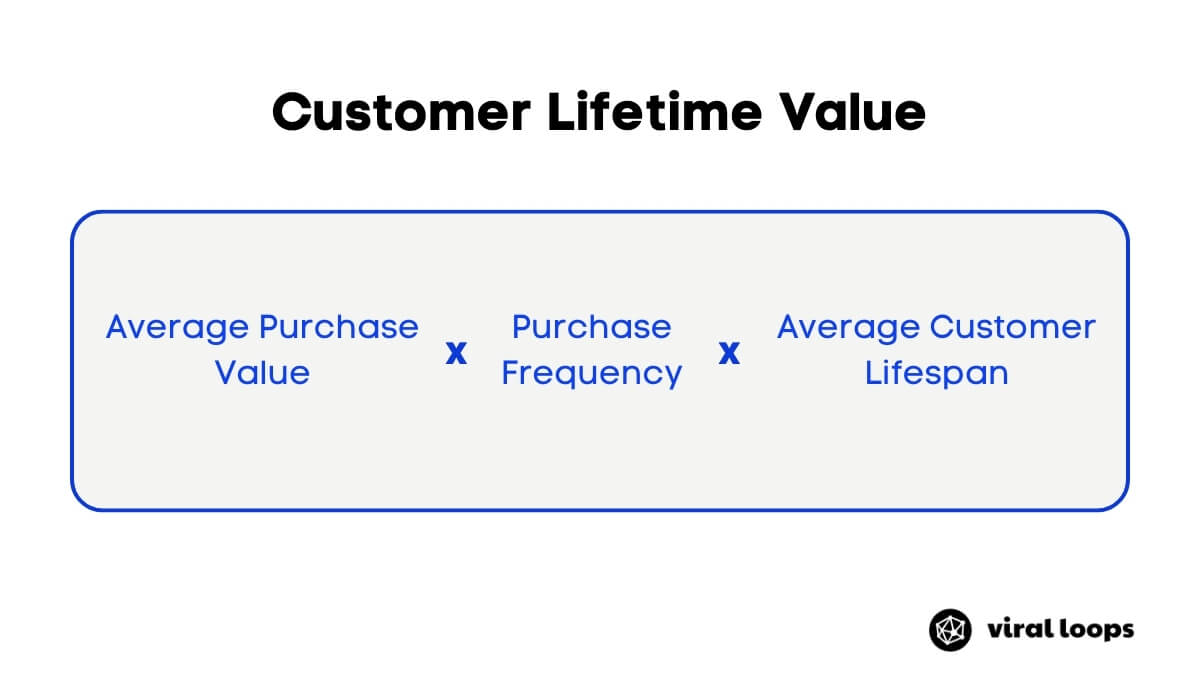
CLV has three main components:
- Average Purchase Value
- Calculated as: Total Revenue ÷ Number of Purchases
- Represents how much a customer spends per transaction
- Purchase Frequency
- Calculated as: Number of Purchases ÷ Time Period
- Shows how often a customer makes a purchase
- Average Customer Lifespan
- The average duration of a customer’s relationship with your business
- Typically measured in years or months
This basic CLV formula can be refined further by:
- Including profit margins instead of revenue
- Factoring in customer acquisition costs
- Applying a discount rate for future revenue
- Considering churn rate
Translation? Take what a customer spends with you (aka customer value) and multiply it by how long they stick around (average customer lifespan). Voilà, you’ve got a metric that measures the gold mine each customer represents!
Now, here’s the exciting twist. Referred customers usually score a higher CLV than others.
Why? Because they walk in the door already trusting you—thanks to the glowing endorsement of a friend or family member. It’s like skipping the awkward “getting to know you” phase and jumping straight into a loyal relationship.
These customers stick around longer, spend more, and, oh yeah, often refer others too.
When you focus on boosting CLV, you’re not just chasing short-term sales. You’re building lasting relationships and sustainable growth.
Customer Lifetime Value is your golden ticket to understanding how much revenue a customer adds to your brand over their entire relationship with you. Share on X6. Cost per Acquisition (CPA)
Tracking financial metrics is crucial for measuring the cost-effectiveness and profitability of your referral program. As such, this is a must-watch metric.
Essentially, Cost per Acquisition (CPA) is the cost of acquiring new customers, whether through paid or organic means.
Referral marketing is your organic strategy, and the costs involved here include:
- cost of running the actual program (like when using referral program software and email marketing programs)
- cost of providing referral incentives
- administrative costs, and
- any promotional expenses to encourage participation.
With referrals, CPA often stays lower than with traditional campaigns. This happens because referrals rely on happy customers to bring in new business, saving advertising costs.
Use this formula to calculate CPA from referrals:
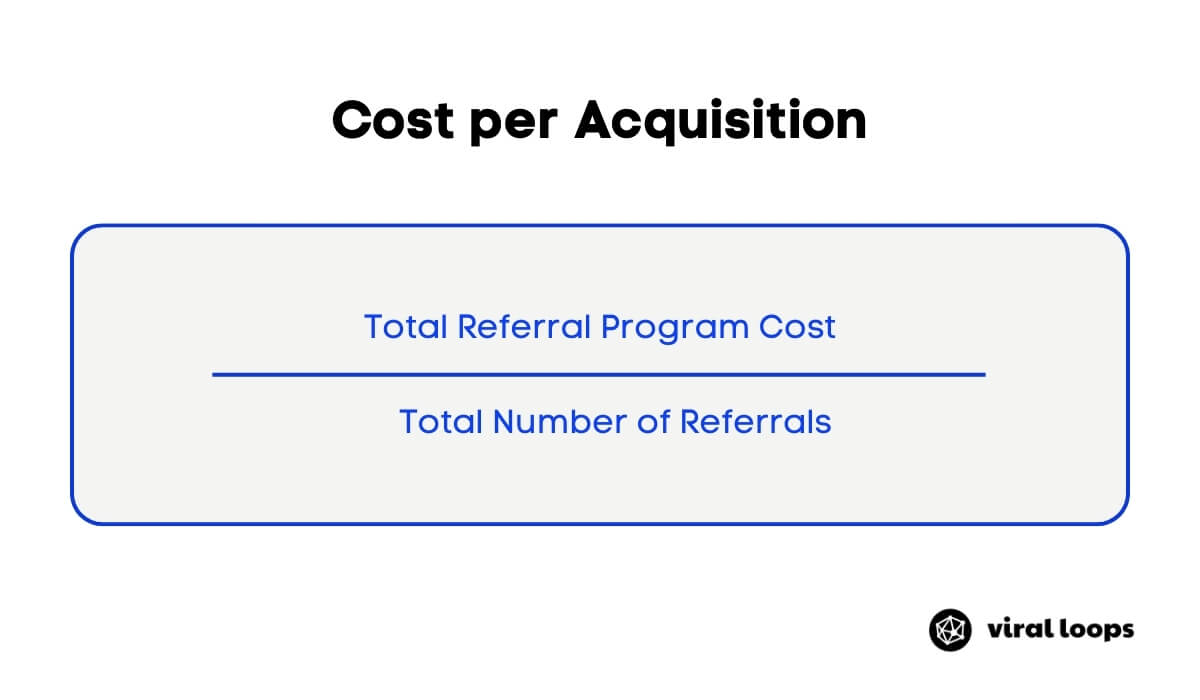
A well-optimized referral program typically yields a lower CPA compared to traditional marketing channels because it leverages the trust and relationships of existing customers.
By tracking CPA, businesses can evaluate the ROI of their referral program and make data-driven decisions about reward structures and program optimization.
These financial insights empower smarter budgeting and strategy decisions. The right metrics tell you where to invest, what’s working, and how referrals contribute to your success. Financial clarity means stronger, more impactful results.
How to Measure Referral Program KPIs
Tracking your KPIs isn’t just an unnecessary burden—it’s essential for achieving success.
But you don’t need to be a data expert to monitor your KPIs. With the right focus and tools, anyone can turn KPIs into a powerful guide for growth, and here’s how to get started:
1. Set Up Tracking Systems
To make your referral program thrive, start with a solid tracking system.
Referral marketing tools are the go-to for bigger programs. These nifty tools integrate with your existing setup, making your life easier.
They track activity, automate workflows, and serve real-time data like a buffet.
Plus, dashboards give you instant access to all the juicy metrics—referrals, redemptions, conversions—you name it.
Running a smaller program and don’t need the bells and whistles? No sweat. You can try manual tracking. A trusty spreadsheet works wonders for logging referred customers, incentive redemptions, and overall performance. Set up a clear system to organize participant data and prevent anything from falling through the cracks. However, it takes great effort.
Viral Loops is the best option for small to large companies.
It has a free trial that smaller businesses can use to test their needs, and a Startup Plan that’s easy on the budget.
Viral Loops also has a Power Plan that works for companies that expect to receive up to 25,000 leads. If you need more, there’s the Custom Plan for your large-scale referral programs.
Whichever method you choose, track those big-hit KPIs—participation rates, CPA, and revenue impact.
2. Collect and Analyze Data
Want your referral program to shine? It starts with collecting accurate data, plain and simple.
Now, don’t just wing it with tracking. Tools like Viral Loops exist for this reason: to make life way easier. This platform lets you monitor links, rewards, and participant activity without breaking a sweat. Bonus? Real-time insights and sleek dashboards that spotlight your key metrics so you stay laser-focused.
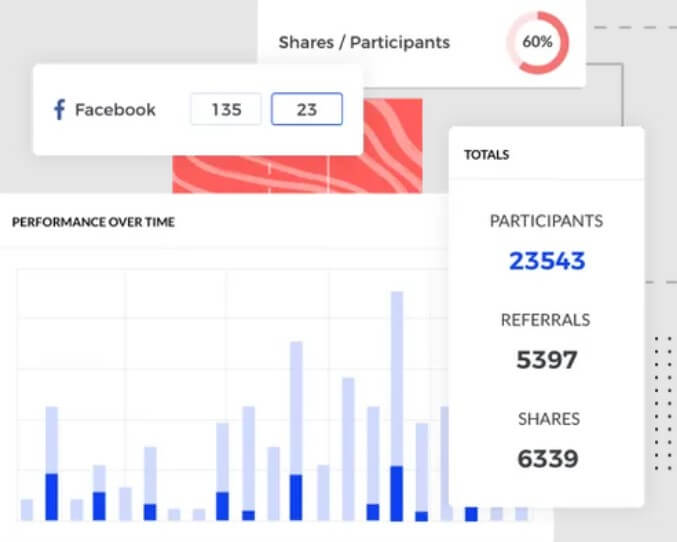
But don’t stop at numbers. Add some qualitative love to the mix. Dig into the story behind those clicks.
Participant behavior, engagement levels, and satisfaction have plenty to say. Go ahead and ask participants what motivated them—or what kept them stuck. Yes, surveys and interviews are worth it.
When you combine these insights, magic happens. Those juicy details help you tweak referral processes, fine-tune messaging, and make incentives irresistible. And when do participants stay engaged? Oh, the results will roll in.
3. Compare Key Benchmarks and Standards
Every successful referral program starts with solid benchmarks.
Industry standards, such as referral rates, conversions, and customer acquisition costs, provide a baseline. These data points highlight where you shine and reveal growth opportunities.
Looking at the pros doesn’t hurt either. Knowing the averages can serve as benchmarks ensure your targets are ambitious but achievable.
The real magic happens when you blend industry metrics with your own. Dig into your data—participant activity, referral traffic, reward redemptions—these numbers tell your program’s unique story. Forget one-size-fits-all; this is personalized performance tracking at its best.
Here’s a simple overview of how referral programs work in different business areas:
- E-commerce (Online Shopping)
- When stores use referral programs, more people buy their products. Studies show that when someone is referred by a friend, they are 4 times more likely to buy something compared to people who find the store on their own (Source: Nielsen).
- After starting referral programs, online stores see their sales go up by 20-30% (Source: Shopify).
- Research by Extole found that 83% of people trust what their friends and family recommend more than they trust ads.
- Software-as-a-Service (SaaS)
- SaaS companies that use referral programs grow 3 times faster than those that don’t (Source: SaaSOptics).
- These programs help bring in 30-50% of new customers, depending on the company.
- Referred customers spend more money over time. They bring in 16% more money than other customers (Source: HubSpot).
- Retail (Physical Stores)
- Stores using referral programs see their sales increase by 10-15% (Source: Shopify).
- 22% of customers will tell others about the store if the referral program is simple to use (Source: BigCommerce).
- Financial Services
- These companies get many more new customers through referrals. The number of new customers can go up by 20% to 40% (Source: Accenture).
- When these companies give cash or rewards for referrals, 50% more people take part in the program (Source: Deloitte).
- Telecommunications
- Phone and internet companies get many customers through referrals. About 30% of their new customers come from referrals (Source: McKinsey & Company).
- Customers who join through referrals stay longer. They are 30% less likely to leave compared to other customers.
- Travel and Hospitality
- In the travel business, 15-20% of all bookings come from referrals (Source: Travel Agent Central).
- Companies that use these programs see 20-25% more bookings just from referrals.
- Healthcare
- When healthcare companies use referral programs, they get 25-35% more customers for services like health insurance and medical care (Source: McKinsey & Company).
- Patients who come through referrals take better care of their health. They are 30% more likely to follow their treatment plans (Source: Health Affairs).
- Real Estate
- In real estate, referral programs help close 30% of home sales (Source: Redfin).
- Real estate agents who use referral programs make 50% more money from referred clients compared to other clients (Source: Inman).
Recommended Reading: Referral Marketing Statistics
Big goals are great, but smaller ones seal the deal. Focus on lifting participation rates or lowering acquisition costs. Tackling these bite-sized targets makes spotting progress while building toward those big wins easier.
Never lose sight of your numbers. Compare results regularly against benchmarks and your own milestones to refine strategies. This keeps your program sharp, steady, and constantly evolving.
4. Use Data to Improve Referral Strategy
Data doesn’t lie—it lays it all out for you. It shows what’s thriving and what needs fixing.
Spot the strengths, like a spike in referral rates or reward redemptions, to see what’s hitting the mark.
Weak points? Maybe low participation rates or stalling conversions. These are your red flags to tackle head-on.
Dive into the trends to uncover the story behind the numbers. Frequent reward redemptions but sluggish sign-ups? That might mean it’s time to tweak how you’re pitching your program. Data gives you more than answers; it hands you the “why” behind those patterns.
Turn those insights into action. If participation looks weak, streamline the process to remove any roadblocks.
Do you have rewards that people love? Double down on them and promote them even harder. Strengthen the good while strengthening the lagging spots.
Never skip experimenting. Test various incentives, refine your messaging, or adjust timelines, and then measure the results. When backed by data, small shifts create noticeable boosts.
Keep revisiting your numbers because trends never sit still. Adapting to these changes ensures your referral program stays sharp and effective.
Final Word
Tracking referral marketing KPIs isn’t just helpful—it’s essential. It’s your guide to what’s crushing it (and what’s falling flat) in your referral program. Think of it as your all-in-one secret weapon, keeping your program thriving and your strategy unstoppable.
Now, why wait? Success doesn’t hang around for fence-sitters. The best time to start tracking is right now. Viral Loops will help you measure your program’s impact and optimize for results. Don’t leave your referral program to guesswork! Book a free demo today.
